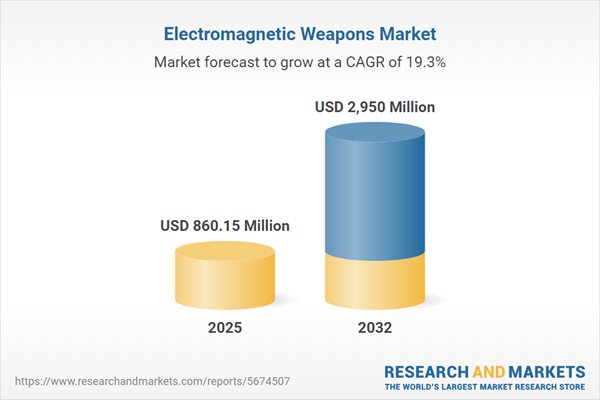Speak directly to the analyst to clarify any post sales queries you may have.
The electromagnetic weapons market is evolving rapidly as defense organizations seek advanced, non-kinetic tools that offer flexible solutions in response to complex operational demands. Staying informed on market direction, technology shifts, and supply chain factors has become critical to sustain mission preparedness.
Market Snapshot: Electromagnetic Weapons Market Growth and Opportunity
The electromagnetic weapons market is experiencing significant growth, fueled by technological advancements and heightened investment in defense and homeland security initiatives. Valued at USD 720.94 million in 2024, the market is expected to reach USD 860.15 million in 2025, representing a robust compound annual growth rate of 19.26%. This upward movement results from increasing adoption of high power microwave systems, state-of-the-art laser devices, and electromagnetic pulse (EMP) solutions across both military and civil defense sectors. Enhanced operational readiness and the shift toward adaptable non-kinetic capabilities are enabling organizations to proactively address a wider variety of threat scenarios. Innovation and resilience remain central as armed forces, government bodies, and industry leaders navigate a dynamic global defense landscape.
Scope & Segmentation: Insights Across the Electromagnetic Weapons Market
- Weapon Type: Fixed, mobile, and portable EMP systems are engineered to support operations ranging from large-scale infrastructure protection to swift tactical missions, offering scalability and mission-specific flexibility.
- Platform: Airborne, land-based, and maritime integration ensures that electromagnetic weapon systems are accessible for strategic deployment in diverse environments, contributing to comprehensive defense and security coverage.
- Application: Key uses include protecting critical assets, supporting both offensive and defensive strategies, and sustaining research-focused deployments to drive sustained innovation in system design and deployment.
- End User: Military organizations, government agencies, homeland security authorities, and research institutions each leverage these solutions to reinforce national defense, accelerate technology evolution, and inform defense policy decisions.
- Technology: Hybrid, plasma-based, solid-state, and vacuum tube solutions provide the technical foundation for scalable, reliable, and tailored system performance, allowing end users to align technology choices with their operational needs.
- Region: Regional leadership and participation is demonstrated by the Americas, Europe, Middle East & Africa, and Asia-Pacific, with active demand and development from key nations including the United States, China, Germany, India, Japan, and major Southeast Asian markets. This ensures global collaboration, supply continuity, and alignment with local defense strategies.
- Key Players: Leading organizations—Lockheed Martin, Raytheon Technologies, BAE Systems, Northrop Grumman, Boeing, General Atomics Aeronautical Systems, Thales, Rafael Advanced Defense Systems, L3Harris Technologies, and Airbus Defence and Space—are shaping the sector through ongoing development and strong partnerships.
Key Takeaways: Strategic Insights for Decision-Makers
- Directed energy and electromagnetic systems empower organizations with versatile, adaptable responses to emerging and evolving defense challenges.
- Collaboration between industry pioneers and research partners accelerates innovation cycles, delivering solutions that address current and emerging threats.
- Non-kinetic platforms provide nuanced control and help organizations manage escalation, enhance risk mitigation, and maintain readiness in rapidly changing environments.
- Modular design and open architectures support seamless upgrades and ensure compatibility with both legacy infrastructure and next-generation defense solutions.
- Artificial intelligence integration augments precision and operational reliability, offering real-time automation and monitoring that improves mission outcomes.
- Resilient and diversified supply chains underpin system availability, reducing vulnerabilities and enabling sustained operations even amid international trade uncertainties.
Tariff Impact: Navigating Global Trade Shifts on Electromagnetic Weapons Supply Chains
Recent U.S. trade tariffs are prompting major shifts across electromagnetic weapons supply chains. Senior stakeholders are reassessing supplier agreements, boosting domestic manufacturing, and reconfiguring logistics strategies to secure ongoing access to essential components. These actions are key to ensuring continuity and stability as global trade dynamics evolve.
Methodology & Data Sources
The report findings derive from verified market data, detailed supply chain assessments, peer-reviewed research, and insights from subject matter experts. Rigorous validation ensures that each conclusion supports robust strategic planning and reliable market forecasting.
Why This Report Matters for Leadership and Strategic Planning
- Enables senior leaders to identify and capitalize on market changes, implementing advanced electromagnetic weapon technologies ahead of competitors.
- Delivers actionable intelligence for optimizing supply chain strategies, reducing risk exposure, and maintaining operational stability in a variable regulatory environment.
- Supports informed investment decisions, strengthening reliability and preparedness for the next generation of defense technology challenges.
Conclusion: Staying Ahead in Electromagnetic Defense
Strategic advancement in technology and supply resilience remains vital for organizations focused on operational continuity in electromagnetic defense. Quick adaptation to developing technologies and market conditions will reinforce effectiveness and leadership within the sector.
Additional Product Information:
- Purchase of this report includes 1 year online access with quarterly updates.
- This report can be updated on request. Please contact our Customer Experience team using the Ask a Question widget on our website.
Table of Contents
3. Executive Summary
4. Market Overview
7. Cumulative Impact of Artificial Intelligence 2025
Companies Mentioned
The companies profiled in this Electromagnetic Weapons market report include:- Lockheed Martin Corporation
- Raytheon Technologies Corporation
- BAE Systems plc
- Northrop Grumman Corporation
- The Boeing Company
- General Atomics Aeronautical Systems, Inc.
- Thales S.A.
- Rafael Advanced Defense Systems Ltd.
- L3Harris Technologies, Inc.
- Airbus Defence and Space GmbH
Table Information
| Report Attribute | Details |
|---|---|
| No. of Pages | 186 |
| Published | October 2025 |
| Forecast Period | 2025 - 2032 |
| Estimated Market Value ( USD | $ 860.15 Million |
| Forecasted Market Value ( USD | $ 2950 Million |
| Compound Annual Growth Rate | 19.2% |
| Regions Covered | Global |
| No. of Companies Mentioned | 11 |









